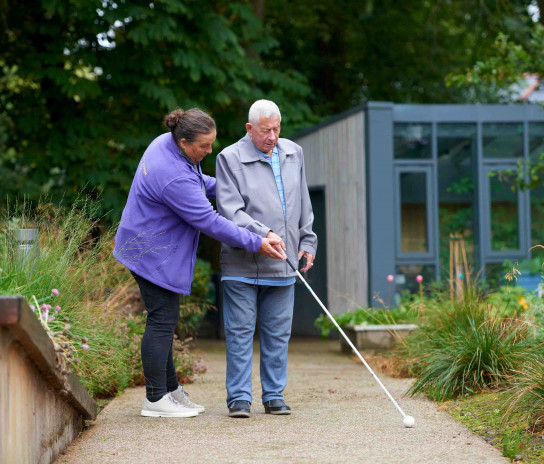Being given the opportunity to reconnect with a previous passion, or getting the satisfaction of learning a new skill along with new friends, can have a huge positive impact on a person’s mental health, increasing their confidence and self-worth.
Unfortunately, having a visual impairment can sometimes be lonely and quite isolating.
We are all very creative. With our amazing brains, we have the ability to generate and explore a variety of innovative thoughts and ideas throughout any given day. At a whim, we can whisk ourselves back in time to reflect on a cherished memory or jump forward to visualise any number of possible futures. Our brains are wired to effortlessly manipulate these thoughts and run scenarios to process emotions, solve problems or simply just let our minds take us on a journey.
The one thing our brains can’t give us however, is perspective on a thought, memory or idea, so we must turn to others to ask for their point of view to gain a more complete understanding of our world. The key to this, of course, is achieved through communication which typically means chatting to a friend, family member or colleague. Through the process of making art however, we have the opportunity to visually show others how we experience and relate to our world. As the adage goes, “a picture is worth a thousand words”.
In our art room at the Hawkhead Centre, we have a thriving community of veterans who create and share their artwork within a space that is designed to promote comradeship, focus and reduce stress. As a tutor, I believe there are three pillars that uphold a positive creative practice: Environment, Community and Tuition.
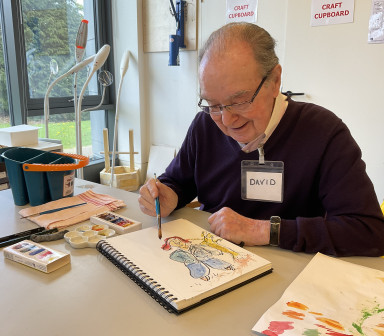
A welcoming environment
It’s no secret that our environment has a great impact on how we feel. In a word, a creative teaching environment should always be salubrious.
It’s a proven fact that when in a more pleasant environment, people find it easier to come out of their shells and interact with one another. In the past, I have attended many art classes that have oddly been the antithesis of this: dirty rooms, loud music, broken materials and poor lighting. It was these poor experiences that helped me to find my place at Sight Scotland Veterans and the Hawkhead Centre, where staff shared the same environmental values as myself.
As the Hawkhead Centre is such a beautiful building, our art room represents the height of homeliness. Bathed in a warm glow from the floor to ceiling windows and bright overhead lights, the space evokes a sense of warmth and well-being. The natural wood accents echo the trees outside the windows while the smell of tea, coffee and soup from the adjacent hub suffuse the air. In keeping with this chill vibe, we play relaxing background music (no radio with news bulletins or spot ads). We place importance on providing our veterans with clean, high quality art materials and excellent task lighting. Our walls are adorned with an inspiring array of veterans’ artworks and our shelves are filled with an eclectic range of fascinating objects to draw and paint. Meanwhile our ample workstations are clean, well laid out and give our artists space to spread out while they work.
The key message we want to give to our veterans is “you are wanted and valued here”.
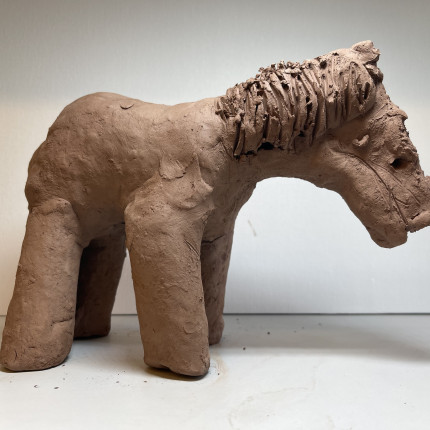
A congenial community
We as a nation are becoming more lonely. To paraphrase author Johann Hari in his startling book Lost Connections, “in a world that has never been more connected, we are all ironically becoming more lonely”.
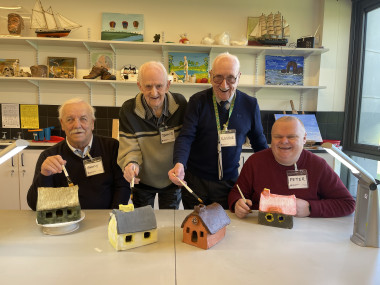
This is particularly true of those of us with severe sight loss. Socialising becomes much harder after experiencing loss of vision. I know from my own experience that it is very difficult to initiate or chime into conversations. Engaging in humorous banter is even harder as comedy is reliant on visually “reading the room” to register the correct timing and pitch for a gag.
Many people with sight loss experience a lack of social confidence and a feeling of alienation. For those that do feel unable to engage in big group discussions, our art room is a haven in which everyone has something in common, offering leading questions such as “what was your idea behind your work?” or “what kind of paint are you using there?” I find that people chat while working, so eyes are fixed on the work, removing the need to maintain eye contact and read hand gestures.
We have a wide variety of experience levels among our art groups and I am often delighted to see more accomplished artists jump to the aid of our newer attendees. I am glad to see them find common ground through their creative process or bond over common experiences with a shared eye condition.
Many sources agree that one of the best antidotes to loneliness is to take part in a group activity. Recently for example, we ran our month-long introduction to traditional clay pottery. A group of veterans, most of whom didn’t consider themselves artists, donned aprons to learn three traditional ways of building with clay. Most admitted that at the start, they found working the clay a bit stressful but by week four, they were proud architects of their very own little clay cottages, pinch pots and coil pots.
I love how group workshops like these spark new friendships and galvanise existing connections between participants. As everyone was working towards the same goal and responding to the same prompt, the art room was always abuzz with banter. Now aware of their capabilities with clay, a couple of our new sculptors are developing their own projects. One person is combining pinch pots to make a shire horse while another is building a fishermen’s cottage, complete with rowboat and lobster pots!
Tailored Tuition
I believe that anyone can draw, paint and sculpt and should give it a try if they feel inclined. Art, after all, can make us better communicators. The key to success is persistence, resilience and self care when your process hits a bump in the road. With plentiful online videos on YouTube and courses from learning platforms like Skillshare, aspiring artists have never had more support.
I love these resources myself but realise there is no substitute for in-person tuition. As an in-house tutor, it's my job to personalise artists’ tuition to suit their individual needs by listening and responding to their aspirations, inspirations and accessibility requirements.
As a visually impaired artist myself, I know how it feels to get tired or frustrated when my sight loss gets in the way of a project. That’s why I know lots of neat little life-hacks that help streamline our artists’ workflow – from quality task lighting and easy-read coloured casings for our paint tubes, to raised work stations to non-slip mats for water pots and paint brushes.
Did you know that contrary to common beliefs, complex details do very little for a drawing or painting? The truth is that getting the big shapes are what make for a good picture. So those of us with sight loss need not worry about closely studying our subjects. I love the artists adage “In art, details and colours get all the credit when Shapes and values do all the work.”
Making art is lauded as being a very therapeutic activity and indeed it can be, once you’ve put in some practice, acclimated yourself with your chosen materials and understood the steps that go into completing a project. In truth, for most people – including the pros – creating a work of art can prove stressful at the outset, but gets easier the longer you spend with your project. Having an art tutor on hand to help students through these early challenging stages can mean the difference between giving up, and pushing through.
Artists of all levels speak of the early stages of a project as being the necessary messy or ugly steps that help us get to the fun stages where we add superfluous details and flourishes.
I often say to our newer artists: “Making art is like climbing a snowy mountain so we can enjoy skiing down the other side.You have a goal in mind but must endure a tricky climb to reach the summit. You’ll have to carry out the initial messy stages of a work, but we’re here to help you find the best path so that on your next trip, you’ll know your own way forward”.
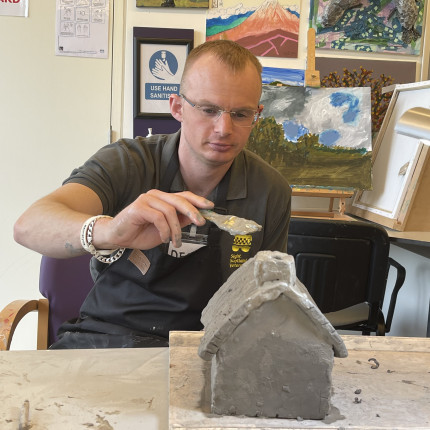
The Trouble With Talent
When I ask people if they would like to give drawing, painting or sculpture a try, they often respond in the same way. A nervous smile is accompanied by the phrase “oh no thanks! I’m not gifted. I don’t have any talent”.
We would have more artists in our world, sharing their creative voice were it not for the “T word”, that perennial excuse not to start or resume a creative journey. All to often, people’s enthusiasm has been extinguished at a fairly young age by parents, teachers or peers. We are told that we are not gifted at art so might as well quit while we’re behind.
The truth is that art, like music, a language or a sport can be learned through experimentation and an understanding that we must accept the small victories before we can see grand results. The only reason pro artists achieve their standard of work is thanks to time spent sketching and dabbling with a mindset of enthusiasm, patience and self care.
“to get good, it's helpful to be willing, or even enthusiastic, about being bad. Baby steps are the royal road to skill.” -Daniel Coyle, author of The Talent Code.
Making art in a group setting can feel a lot like starting out at the gym. It takes bravery to start, to accept our initial vulnerability and nourish the hope that the environment is welcoming while our peers and tutors will be respectful of our current level. At Hawkhead, we strive to ensure everyone is appreciated and supported regardless of where the are in their creative journey. We support artists of all skill levels and have seen everyone flourish by tapping into what they are excited about and nourishing that enthusiasm. We see a wide gamut of interests including watercolour cartoons, expressive acrylic portraits, clay gargoyles and surreal pen and ink designs.
Our Door is Open
What interests you? How would you like to express them through shape, colour and texture? If you attend either of our centres and would like to start or resume your own artistic journey with us, please do get in touch.
We teach beginner’s drawing in pencil and ink, watercolour, gouache and acrylic painting and of course traditional clay pottery. We are also running regular clay workshops, so please let us know if you would like to take part.
I can guarantee you’ll find a warm welcome here in the art room whatever your goals or level of experience.
Best wishes,
Michael - Volunteer art tutor, The Hawkhead Centre
You may also be interested in
Telephone group friends meet face-to-face
A group of veterans with visual impairment who bonded over telephone support groups are now meeting at our activity centre! The reunion took place the Hawkhead Centre, our activity centre in Paisley for veterans with sight loss.
How we can help
Across Scotland, we provide support to empower ex-service personnel affected by changes to their sight to regain confidence, restore independence and make new connections.
Veterans News and Stories
Whether you're a veteran with sight loss, or want to help veterans with sight loss, keep in touch with what's happening in our world with the latest news, stories, and blogs from Sight Scotland Veterans.
